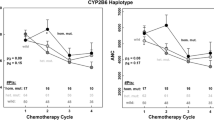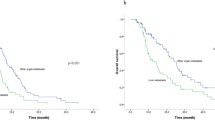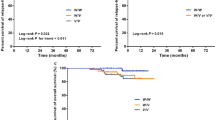Abstract
Purpose
A prospective study was performed to compare the outcome for metastatic breast cancer (MBC) patients treated with docetaxel plus thiotepa (DT) or docetaxel plus capecitabine (DC), and to explore the value of CYP1A1*2C polymorphisms in predicting clinical efficacy of these chemotherapies.
Methods
MBC patients (n = 130) were randomized to treatment with DT (n = 65) or DC (n = 65). Response rate, disease control rate, progression-free and overall survival were monitored. Genotyping of CYP1A1*2C was performed in all patients.
Results
DT and DC produced similar overall disease control rates (76.9 vs 69.2%), median PFS (6.7 vs. 7.5 months) and OS (20.1 vs. 21.0 months) (P > 0.05 for all comparisons); however, DT exhibited a higher rate of control of localized liver metastases (78.6 vs 41.2%, P = 0.023). Among patients homozygous for wild-type CYP1A1*1 genotype (AA), DT treatment was associated with a significantly longer PFS (8.4 vs. 6.4 months, P = 0.019) and OS (33.4 vs. 15.8 months, P = 0.018). Conversely, among patients carrying the variant CYP1A1*2C genotype (AG/GG), DC treatment was associated with a significantly longer PFS (8.4 vs. 5.5 month, P = 0.005), and OS (28.5 vs. 19.6 months, P = 0.010). After adjusting for competing risk factors, CYP1A1*2C genotype was confirmed to be an independent predictor of PFS and OS for each chemotherapy combination.
Conclusions
Overall, DT and DC result in similar clinical efficacy for MBC patients; however, efficacy for each therapy differs depending on CYP1A1*2C genotype.



Similar content being viewed by others
References
Huntington SF, Gross CP (2016) Negative studies in cancer research: why the negativity? JAMA Oncol 2(7):865–866. https://doi.org/10.1001/jamaoncol.2015.6540
McLeod HL (2013) Cancer pharmacogenomics: early promise, but concerted effort needed. Science 339(6127):1563–1566. https://doi.org/10.1126/science.1234139
Sadee W (2011) Pharmacogenomic biomarkers: validation needed for both the molecular genetic mechanism and clinical effect. Pharmacogenomics 12(5):675–680. https://doi.org/10.2217/pgs.11.23
Zembutsu H (2015) Pharmacogenomics toward personalized tamoxifen therapy for breast cancer. Pharmacogenomics 16(3):287–296. https://doi.org/10.2217/pgs.14.171
Harper AR, Topol EJ (2012) Pharmacogenomics in clinical practice and drug development. Nat Biotechnol 30(11):1117–1124. https://doi.org/10.1038/nbt.2424
Gradishar WJ, Anderson BO, Balassanian R, Blair SL, Burstein HJ, Cyr A, Elias AD, Farrar WB, Forero A, Giordano SH, Goetz M, Goldstein LJ, Hudis CA, Isakoff SJ, Marcom PK, Mayer IA, McCormick B, Moran M, Patel SA, Pierce LJ, Reed EC, Salerno KE, Schwartzberg LS, Smith KL, Smith ML, Soliman H, Somlo G, Telli M, Ward JH, Shead DA, Kumar R (2015) NCCN guidelines insights breast cancer, Version 1.2016. J Natl Compr Canc Netw 13(12):1475–1485
Dong N, Yu J, Wang C, Zheng X, Wang Z, Di L, Song G, Zhu B, Che L, Jia J, Jiang H, Zhou X, Wang X, Ren J (2012) Pharmacogenetic assessment of clinical outcome in patients with metastatic breast cancer treated with docetaxel plus capecitabine. J Cancer Res Clin Oncol 138(7):1197–1203. https://doi.org/10.1007/s00432-012-1183-5
Thiotepa (2011). Report on carcinogens. Carcinog Profiles 12:406–407
Dardis C, Milton K, Ashby L (2015) Whither thiotepa (for patients in the USA)? J Neuro-oncol 124(3):529–530. https://doi.org/10.1007/s11060-015-1856-4
Berry DA, Ueno NT, Johnson MM, Lei X, Caputo J, Rodenhuis S, Peters WP, Leonard RC, Barlow WE, Tallman MS, Bergh J, Nitz UA, Gianni AM, Basser RL, Zander AR, Coombes RC, Roche H, Tokuda Y, de Vries EG, Hortobagyi GN, Crown JP, Pedrazzoli P, Bregni M, Demirer T (2011) High-dose chemotherapy with autologous stem-cell support as adjuvant therapy in breast cancer: overview of 15 randomized trials. J Clin Oncol 29(24):3214–3223. https://doi.org/10.1200/JCO.2010.32.5910
Rodenhuis S, Bontenbal M, van Hoesel QG, Smit WM, Nooij MA, Voest EE, van der Wall E, Hupperets P, van Tinteren H, Peterse JL, van de Vijver MJ, de Vries EG, Netherlands Working Party on Autologous Transplantation in Solid T (2006) Efficacy of high-dose alkylating chemotherapy in HER2/neu-negative breast cancer. Ann Oncol 17 (4):588–596. https://doi.org/10.1093/annonc/mdl001
Wang X, Ren J, Zhang J, Yan Y, Jiang N, Yu J, Di L, Song G, Che L, Jia J, Zhou X,Yang H, Lyerly HK (2016) Prospective study of cyclophosphamide, thiotepa, carboplatin combined with adoptive DC-CIK followed by metronomic cyclophosphamide therapy as salvage treatment for triple negative metastatic breast cancers patients (aged < 45). Clin Trans Oncol 18 (1):82–87. https://doi.org/10.1007/s12094-015-1339-2
Hagen B (1991) Pharmacokinetics of thio-TEPA and TEPA in the conventional dose-range and its correlation to myelosuppressive effects. Cancer Chemother Pharmacol 27(5):373–378
Lu Z, Jia J, Di L, Song G, Yuan Y, Ma B, Yu J, Zhu Y, Wang X, Zhou X, Ren J (2011) DNA methyltransferase inhibitor CDA-2 synergizes with high-dose thiotepa and paclitaxel in killing breast cancer stem cells. Front Biosci (Elite Ed) 3:240–249
Ren J, Di L, Song G, Yu J, Jia J, Zhu Y, Yan Y, Jiang H, Liang X, Che L, Zhang J, Wan F, Wang X, Zhou X, Lyerly HK (2013) Selections of appropriate regimen of high-dose chemotherapy combined with adoptive cellular therapy with dendritic and cytokine-induced killer cells improved progression-free and overall survival in patients with metastatic breast cancer: reargument of such contentious therapeutic preferences. Clin Trans Oncol 15(10):780–788. https://doi.org/10.1007/s12094-013-1001-9
Yu J, Lj DI, Song G, Che L, Jiang H, Zhu Y, Liang X, Jia J, Zhang J, Yang H, Wang X, Zhou X, Ren J (2011) Randomized clinical case-control trial for the comparison of docetaxel plus thiotepa versus docetaxel plus capecitabine in patients with metastatic breast cancer. Beijing Da Xue Xue Bao 43(1):151–156
Song Q, Zhou X, Yu J, Dong N, Wang X, Yang H, Ren J, Lyerly HK (2015) The prognostic values of CYP2B6 genetic polymorphisms and metastatic sites for advanced breast cancer patients treated with docetaxel and thiotepa. Sci Rep 5:16775. https://doi.org/10.1038/srep16775
Zhou X, Wang X, Song Q, Yang H, Zhu X, Yu J, Song G, Di L, Ren J, Shao H, Lyerly HK (2015) Transformation of alkylating regimen of thiotepa into tepa determines the disease progression through GSTP1 gene polymorphism for metastatic breast cancer patients receiving thiotepa containing salvage chemotherapy. Int J Clin Pharmacol Ther 53(11):914–922. https://doi.org/10.5414/CP202391
Therasse P, Arbuck SG, Eisenhauer EA, Wanders J, Kaplan RS, Rubinstein L, Verweij J, Van Glabbeke M, van Oosterom AT, Christian MC, Gwyther SG (2000) New guidelines to evaluate the response to treatment in solid tumors. European Organization for Research and Treatment of Cancer, National Cancer Institute of the United States, National Cancer Institute of Canada. J Natl Cancer Inst 92(3):205–216
de Kock I, Mirhosseini M, Lau F, Thai V, Downing M, Quan H, Lesperance M, Yang J (2013) Conversion of Karnofsky Performance Status (KPS) and Eastern Cooperative Oncology Group Performance Status (ECOG) to Palliative Performance Scale (PPS), and the interchangeability of PPS and KPS in prognostic tools. J Palliat Care 29(3):163–169
O’Shaughnessy J, Miles D, Vukelja S, Moiseyenko V, Ayoub JP, Cervantes G, Fumoleau P, Jones S, Lui WY, Mauriac L, Twelves C, Van Hazel G, Verma S, Leonard R (2002) Superior survival with capecitabine plus docetaxel combination therapy in anthracycline-pretreated patients with advanced breast cancer: phase III trial results. J Clin Oncol 20(12):2812–2823. https://doi.org/10.1200/JCO.2002.09.002
Li J, You J, Si W, Zhu Y, Chen Y, Yang B, Han C, Linghu R, Zhang X, Jiao S, Yang J (2015) Docetaxel/S-1 versus docetaxel/capecitabine as first-line treatment for advanced breast cancer: a retrospective study. Medicine (Baltimore) 94(41):e1340. https://doi.org/10.1097/MD.0000000000001340
John M, Hinke A, Stauch M, Wolf H, Mohr B, Hindenburg HJ, Papke J, Schlosser J, Group FS (2012) Weekly paclitaxel plus trastuzumab in metastatic breast cancer pretreated with anthracyclines—a phase II multipractice study. BMC cancer 12:165. https://doi.org/10.1186/1471-2407-12-165
Fabi A, Giannarelli D, Malaguti P, Ferretti G, Vari S, Papaldo P, Nistico C, Caterino M, De Vita R, Mottolese M, Iacorossi L, Cognetti F (2015) Prospective study on nanoparticle albumin-bound paclitaxel in advanced breast cancer: clinical results and biological observations in taxane-pretreated patients. Drug Des Devel Ther 9:6177–6183. https://doi.org/10.2147/DDDT.S89575
Vici P, Fabi A, Metro G, Sergi D, Giannarelli D, Di Lauro L, Bepler G, Tomao F, Cognetti F, Conti F, Lopez M (2011) Phase I–II trial of prolonged gemcitabine infusion plus paclitaxel as a biweekly schedule for advanced breast cancer patients pretreated with anthracyclines. Cancer Chemother Pharmacol 67(3):687–693. https://doi.org/10.1007/s00280-010-1369-y
Redig AJ, McAllister SS (2013) Breast cancer as a systemic disease: a view of metastasis. J Intern Med 274(2):113–126. https://doi.org/10.1111/joim.12084
Venur VA, Leone JP (2016) Targeted therapies for brain metastases from breast cancer. Int J Mol Sci 17 (9). https://doi.org/10.3390/ijms17091543
Biskup E, Cai F, Vetter M (2017) Bone targeted therapies in advanced breast cancer. Swiss Med Wkly 100:w14440. doi:smw.2017.14440
Disibio G, French SW (2008) Metastatic patterns of cancers: results from a large autopsy study. Arch Pathol Lab Med 132(6):931–939. https://doi.org/10.1043/1543-2165(2008)132[931:MPOCRF]2.0.CO;2
Schrama JG, Baars JW, Holtkamp MJ, Schornagel JH, Beijnen JH, Rodenhuis S (2001) Phase II study of a multi-course high-dose chemotherapy regimen incorporating cyclophosphamide, thiotepa, and carboplatin in stage IV breast cancer. Bone Marrow Transplant 28(2):173–180. https://doi.org/10.1038/sj.bmt.1703105
Miller B, Tenenholz T, Egorin MJ, Sosnovsky G, Rao NU, Gutierrez PL (1988) Cellular pharmacology of N,N’,N’’-triethylene thiophosphoramide. Cancer Lett 41(2):157–168
Chang TK, Chen G, Waxman DJ (1995) Modulation of thiotepa antitumor activity in vivo by alteration of liver cytochrome P450-catalyzed drug metabolism. J Pharmacol Exp Ther 274(1):270–275
Scott SA (2011) Personalizing medicine with clinical pharmacogenetics. Genet Med 13(12):987–995. https://doi.org/10.1097/GIM.0b013e318238b38c
Patel JN (2016) Cancer pharmacogenomics, challenges in implementation, and patient-focused perspectives. Pharmgenomics Pers Med 9:65–77. https://doi.org/10.2147/PGPM.S62918
Twelves C, Jove M, Gombos A, Awada A (2016) Cytotoxic chemotherapy: Still the mainstay of clinical practice for all subtypes metastatic breast cancer. Crit Rev Oncol Hematol 100:74–87. https://doi.org/10.1016/j.critrevonc.2016.01.021
Abd El Wahab N, Shafik NF, Shafik RE, Taha Sh A, Shafik HE, Darwish AD (2017) Association of CYP3A5*3 and CYP1A1*2C polymorphism with development of acute myeloid leukemia in Egyptian patients. Asian Pac J Cancer Prev 18(3):747–752. https://doi.org/10.22034/APJCP.2017.18.3.747
Jain V, Ratre YK, Amle D, Mishra PK, Patra PK (2017) Polymorphism of CYP1A1 gene variants rs4646903 and rs1048943 relation to the incidence of cervical cancer in Chhattisgarh. Environ Toxicol Pharmacol 52:188–192. https://doi.org/10.1016/j.etap.2017.04.009
Cho YA, Lee J, Oh JH, Chang HJ, Sohn DK, Shin A, Kim J (2017) Dietary flavonoids, CYP1A1 genetic variants, and the risk of colorectal cancer in a Korean population. Sci Rep 7(1):128. https://doi.org/10.1038/s41598-017-00117-8
Zhou SF, Liu JP, Chowbay B (2009) Polymorphism of human cytochrome P450 enzymes and its clinical impact. Drug Metab Rev 41(2):89–295. https://doi.org/10.1080/03602530902843483
Lakkireddy S, Aula S, Avn S, Kapley A, Rao Digumarti R, Jamil K (2015) Association of the common CYP1A1*2C variant (Ile462Val polymorphism) with chronic myeloid leukemia (CML) in patients undergoing imatinib therapy. Cell J 17(3):510–519
Heubner M, Wimberger P, Riemann K, Kasimir-Bauer S, Otterbach F, Kimmig R, Siffert W (2010) The CYP1A1 Ile462Val polymorphism and platinum resistance of epithelial ovarian neoplasms. Oncol Res 18(7):343–347
Author information
Authors and Affiliations
Corresponding authors
Ethics declarations
Funding
This study was funded by Susan G Komen for Cure Foundation (no. SPCHIN1201), Youth Foundation of Beijing Shijitan Hospital of Capital Medical University (no. 2013-q-04) and China Railway Corporation Research Project (2016-A44).
Conflict of interest
The authors declared that they have no conflicts of interest related to this work.
Ethical approval
All procedures performed in this study were in accordance with the ethical standards of the institutional and/or national research committee and with the 1964 Helsinki declaration and its later amendments or comparable ethical standards.
Informed consent
Informed consent was obtained from all individual participants included in the study.
Electronic supplementary material
Below is the link to the electronic supplementary material.
Rights and permissions
About this article
Cite this article
Zhou, X., Qiao, G., Wang, X. et al. CYP1A1 genetic polymorphism is a promising predictor to improve chemotherapy effects in patients with metastatic breast cancer treated with docetaxel plus thiotepa vs. docetaxel plus capecitabine. Cancer Chemother Pharmacol 81, 365–372 (2018). https://doi.org/10.1007/s00280-017-3500-9
Received:
Accepted:
Published:
Issue Date:
DOI: https://doi.org/10.1007/s00280-017-3500-9




